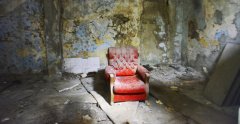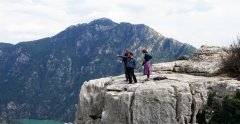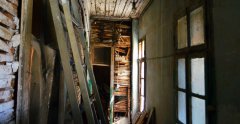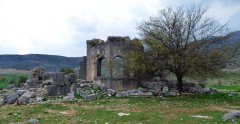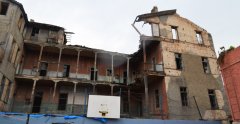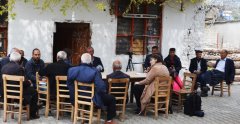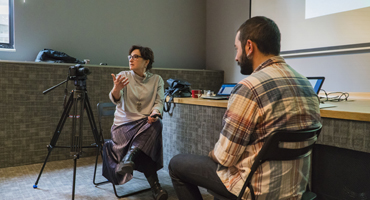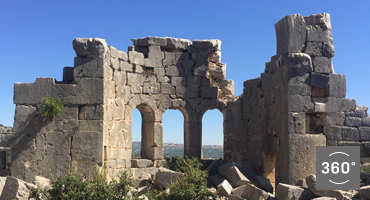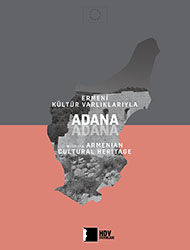Adana is one of the locations we work in the scope of the project Adaptive and Creative Reuse of Sites of Memory. Our work is in progress, after the completion of the fieldwork in April 2017. From one side we work on our planned product of this research, a volume that covers the cultural heritage of Adana, from the other side we continue our work on the oral history interviews we conducted. The fieldwork that covered center of Adana and district of Aladağ, aimed at shedding light on the relationship between cultural heritage in urban and urbanizing environment from one side, and the interconnectedness of nature and cultural heritage in rural environments.
Cultural heritage in Aladağ: Connection with nature
One of Adana’s districts, Aladağ is at a distance of an hour’s drive from the provincial center. Everyday, minibuses commute between Adana and Aladağ parting from the Yüreğir Bus Station in the center. These minibuses pass through Akören, a town in the past, turned to neighborhood of Aladağ district, after the Adana had become “Big City”. In the Cilicia archeology literature, the two church sites are known as Akören I and Akören II. In the 1990’s two archaeologic excavations were able to uncover a portion of area’s history. People in Akören and in Aladağ in general remember these excavations. The information we have on these sites comes specifically from the excavations of Gabriel Mietke.
It is widely accepted that the cultural heritage of the area dates back to the Byzantine era between 5th and 6th centuries AD, and being reused by the Armenians in 12th and 13th centuries AD. Several sources mention that the Byzantine churches of Akören became parts of the Agner Monastery built in 1198 AD. One of the most important proofs of this theory is the fact that the closes village to Akören was called Eğner, until it remained under the waters of the Akören dam. Eğner is the deformed Armenian word Agner - Ակներ, which means “many springs”. Until a couple years ago, Eğner was famous of its springs and watermills, was a popular picnic destination for Adana inhabitants. We encounter mentions of Agner’s springs and watermills in manuscripts dating back 7 centuries. The bird view distance between the village and the monastery is four kilometers.
The car road towards the north of Akören town ends after a five minute drive. From here a half hour’s hike in the fields brings to the first site, and towards east from there above the hills brings to the second site. We were able to draw the detailed track of this hike in collaboration with Alen Mavlat and Derya Engin, who joined us in our field trip from the Doğa Derneği (Association for Nature). Together with the Doğa Derneği, we ran a workshop of preparing a guidebook that explains the the cultural heritage and traditional agriculture traces and their interconnectedness in the area. As we enjoyed the moral and logistic support of the Aladağ Municipality, apart from Akören, we were able draw similar tracks in Kayabaşı, a former village, turned recently to a street of Uzunkuyu village because of decreasing population.
Cultural heritage victim of urbanization in Adana
After three days in Aladağ, we continued our study in centre of Adana, in the district of Seyhan. Our aim was to have a parallel research on walking tracks, similar to that of Aladağ, but in an urban environment in this case. For this we relied on people that know the city and follow its development closely. Can Durmuşoğlu is an architect based in Adana. We started our tour from Can Durmuşoğlu’s office neighborhood, the Reşatbey.
We observed in Reşatbey neighborhood the first urban transformations of the republican era, the strengthening of the central planning approach and how the Jensen plans were implemented. Moving towards the railroad station, we observed the structure of the station building, its location and its position as axis determining knot point. Enter to Ziya Paşa Boulevard from there, we discussed the social buildup brought up by the urban development of the 1990’s. Next to Atatürk Park, along the location of the old Armenian Cemetery we entered the old city. We observed how the Municipality building has remained out of the public life and detached from the lives of the citizens, and how this is true for many other public buildings, culture centers, even the newly built big mosque. In contrast, the old mosques are and the vanished churches were very close to the people. Talking about the factories, we talked about the Greek Tirpani and Simeonidis, Armenian Gulbenkian and Jewish Gilodo factories, and how in the 1921 the Greek and Armenian and during the Wealth Tax of 1946 the Jewish factories were confiscated, nationalised and sold away.
Passing through the famous Abidin Paşa street, we entered the Tepebağ neighborhood, once home to the vital Armenian community of Adana. We admired the Büyük Saat (big clock tower) built in 1882 by Krikor Ağa Bizdigian and Kasbar Ağa Avakian, and the recent change seen by the surrounding streets and markets known as Arastalar (the marketplace). We saw how new buildings are built up next to old unused buildings, by that we witnessed how the theory of reuse is not being implemented. As we passed next to the Central Bank, we learned how this is the location of Surp Asdvadzadzin Armenian Church, and how it was long used as the Tan Cinema and was preserved that way, but later on being a victim of urban transformation, was destroyed in the 70’s. During our research trip we had the chance to gather information on many buildings similar to this. Our work continues on the evaluation of the information we gathered and the best ways of presenting them.
Cultural heritage and oral history
An integral part of our information acquiring process is oral history. Apart from ongoing interviewing parallel to all our activities, the final stage of our fieldwork was the Oral History Workshop. With participants from Adana and Mersin, our training workshop was run by the experienced coordinator of Foundation’s oral history projects, Emine Kolivar. Kolivar explained the oral history methodology and development and presented details on the Foundation’s in depth interview technique along with experiences from past practices. Interview practice with the participants continued in the next two days.
During our field trip many individuals and organizations helped us to great extent. We cannot thank enough the bearers of the memory, those who know where the memory is, and those who shared their memories with us. While we continue working on how we can present what we learned about Adana, we are encouraged by how a great home is the Cilicia-Çukurova region with its great geographic and temporal span, with how much inhabitants of Adana love their city, how sad they are because of loss of the cultural heritage and how deep is the longing of those living abroad. If you too have any knowledge, memory, family story that you are willing to share with us and you think you can contribute to our work, please don’t hesitate to contact us.
Adana cultural heritage in the city and the countryside
Inside an abandoned house in Tepebağ neighborhood
In Kayabaşı, on the Tekerlek (the wheel) rock
The complex that housed the Apkaryan School, today the Nuri Has Pasajı
The 5th century Byzantine church known as Akören I, reused by the Armenians in 12th century
Agner Monastery
Burned in 1909, later renovated, the American Girl's College, despite being part of the Tepebağ Anadolu College today, it is not being used
In Akören, during research with Doğa (Nature) Association



